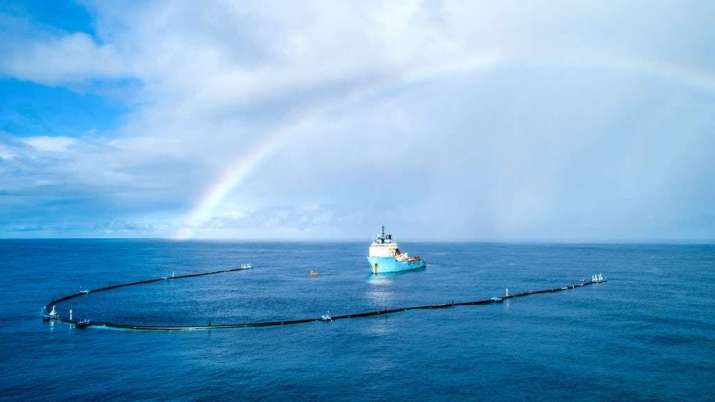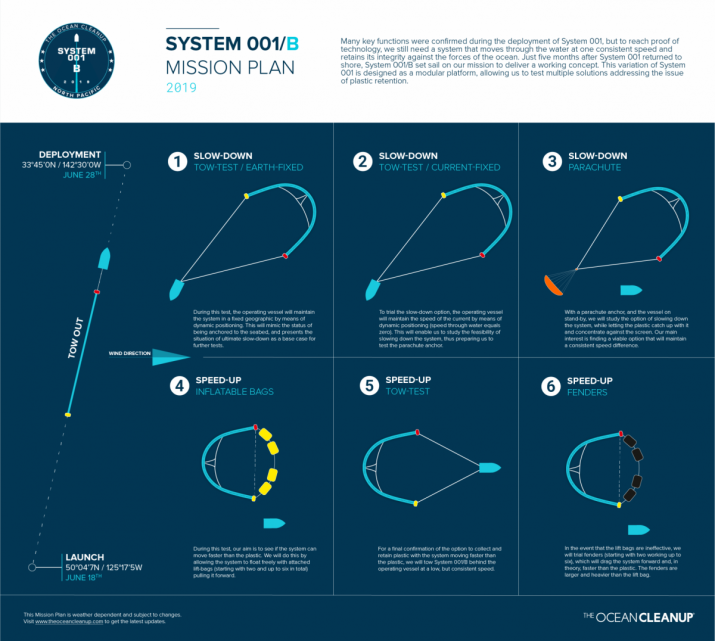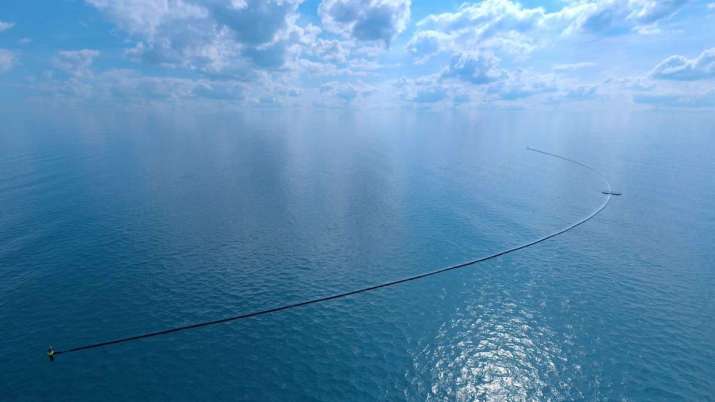
Following years of tests and trials, and an abortive maiden launch,* an innovative marine garbage collection system aimed at tackling the growing environmental crisis of plastic waste accumulating in the Pacific Ocean has been relaunched in a second attempt to clean up the now-infamous roiling island of seaborne refuse known as the Great Pacific Garbage Patch.
The ocean-saving initiative is the brainchild of a resourceful Dutch entrepreneur, 24-year-old Boyan Slat, who is confident that his invention can halve the quantity of plastic waste floating in the Pacific in as few as five years. Slat’s startup, The Ocean Cleanup, founded in 2013 and based in the Netherlands, has developed a system of floating booms that use the ocean’s natural currents to skim swathes of waste floating just below the ocean’s surface to collection points, where it can be extracted and shipped back to shore for recycling.**
The maiden launch of the non-profit venture’s initiative, which set sail from San Francisco in September last year, was aborted in December after it was found that the solar-powered 600-meter barrier moved too slowly to be effective and broke apart under the constant barrage of ocean waves. Over the ensuing months, a team of engineers has redesigned and modified the system that it is hoped will lead what has been described as “the world’s largest ocean cleanup.”
“After only four months of design, procurement, and assembly, the crew is now on their way to the Great Pacific Garbage Patch with the upgraded System 001/B. Time to put it to the test,” The Ocean Cleanup announced on Twitter on 22 June.
“Hopefully nature doesn’t have too many surprises in store for us this time. Either way, we’re set to learn a lot from this campaign,” tweeted Slat.

The Great Pacific Garbage Patch, a widening gyre of trash estimated to be more than twice the size of Texas, is said to contain more than 1.8 trillion pieces of floating plastic—equivalent to 250 pieces of debris for every living human. Sadly, it is not the only marine trash vortex—merely the largest. Similar vortices of waste exist in the Atlantic and Indian oceans, as well as smaller marine regions, such as the North Sea. Each year, humans dump an additional 8 million tonnes of plastic waste into the world’s seas—equivalent to a dump truck full of plastic every minute.
On 28 June, The Ocean Cleanup reported that the redesigned device, dubbed System 001/B, had arrived in the garbage patch after eight days in transit with the floating barrier, which features a tapered three meter screen below the surface of the water designed to trap floating plastic while allowing marine life to safely swim beneath it.
Welcome to the Great Pacific Garbage Patch. It looks like we are in the right spot to test our system. pic.twitter.com/l0qNC6TG16
— The Ocean Cleanup (@TheOceanCleanup) July 2, 2019
Equipped with cameras, sensors, solar-powered lights, and satellite antennas, the clean-up system should be able transmit its position, enabling support vessels to locate the device every few months and load up with accumulated plastic to be shipped back to shore for recycling or safe disposal.
“With every iteration and deployment of our cleanup systems we get closer to reaching proven technology,” The Ocean Cleanup stated in an update on its website. “What we are doing is challenging, though. The road to cleanup is not linear, nor is it easy—but it’s definitely worth doing. During the deployment of System 001/B, we will trial modifications to speed it up or slow it down, with the end goal of creating a consistent speed through plastic that allows us to effectively capture and retain the catch. If we do not achieve proven technology status with this campaign, we will certainly learn a great deal from this system for the next iteration.”

The first tests for the newly deployed collection system will involve regulating its speed in relation to the plastic waste using a parachute anchor and inflatable bags. Once the design is perfected and its efficacy proven, Slat has said he hopes to eventually deploy as many as 60 floating boom arrays to clear plastic debris from the ocean.
The quantity of debris in the Great Pacific Garbage Patch has accumulated because much of it is not biodegradable—many plastics do not completely break down, but simply degrade into smaller particles. Some of these long-lasting plastics end up being consumed by marine animals and their young, including fish, whales and dolphins, turtles, seals, and sea birds, ultimately impacting the entire food chain. At the microscopic level, the floating debris can absorb organic pollutants from seawater, which can also be passed on during consumption by animals. In addition to the dangers to wildlife, many of these fish are consumed by humans, resulting in human ingestion of toxic chemicals. Research indicates that plastic marine debris affects more than 267 species worldwide.

* Largest Cleanup Project in History to Tackle the Great Pacific Garbage Patch (Buddhistdoor Global)
** Dutch Entrepreneur Plans Radical Clean-up of the Great Pacific Garbage Patch (Buddhistdoor Global)
See more
The Ocean Cleanup
The Ocean Cleanup (Facebook)
The Ocean Cleanup (Twitter)
Great Pacific garbage patch: giant plastic trap put to sea again (The Guardian)
Boyan Slat’s Ocean Cleanup project relaunches (MNN)
A new version of the massive plastic cleanup device invented by a 24-year-old is returning to the Great Pacific Garbage Patch (Business Insider)














